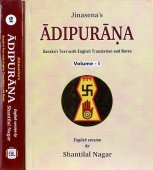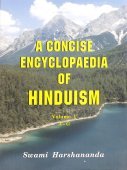Upapurana, Upapurāṇa: 14 definitions
Introduction:
Upapurana means something in Hinduism, Sanskrit, Marathi. If you want to know the exact meaning, history, etymology or English translation of this term then check out the descriptions on this page. Add your comment or reference to a book if you want to contribute to this summary article.
In Hinduism
Purana and Itihasa (epic history)
Source: WikiPedia: PuranasUpapurāṇa (उपपुराण).—The Upapuranas are a genre of Hindu religious texts consisting of a large number of compilations differentiated from the Mahapuranas by styling them as secondary Puranas using a disparaging prefix Upa (secondary).
The list found in the Kurma Purana (Purvabhaga, 1.17-20) provides the following names:
- Adya-purana (Sanatkumara),
- Narasimha-purana,
- Skanda-purana,
- Shivadharma-purana,
- Durvasa-purana,
- Naradiya-purana,
- Kapila-purana,
- Vamana-purana,
- Aushanasa-purana,
- Brahmanda-purana,
- Varuna-purana,
- Kalika-purana,
- Maheshvara-purana,
- Samba-purana,
- Saura-purana,
- Parashara-purana,
- Maricha-purana,
- Bhargava-purana.
The Brihaddharma Purana provides a list of the following eighteen:
- Adi-purana,
- Aditya-purana,
- Brihannaradiya-purana,
- Naradiya-purana,
- Nandishvara-purana,
- Brihannandishavara-purana,
- Samba-purana,
- Kriyayogasara,
- Kalika-purana,
- Dharma-purana,
- Vishnudharmottara-purana,
- Shivadharma-purana,
- Vishnudharma-purana,
- Vamana-purana,
- Varuna-purana,
- Narasimha-purana,
- Bhargava-purana,
- Brihaddharma-purana.
Upapurāṇa (उपपुराण) refers to “supplementary Purāṇas”.—Besides these eighteen Purāṇas there are many Puranic works known as Upapurāṇas. Though the Upapurāṇas are said to be eighteen in number their list is less canonised than that of the eighteen Mahapurāṇas.
As to the origin of the Upapurāṇas the Kurmapurāṇa, Śivamāhātmya-khaṇḍa of the Sūtasaṃhitā of the Skandapurāṇa and the Parāśara-Upapurāṇa record a tradition that the sages proclaimed the Upapurāṇas after listening to the eighteen Purāṇas form Vyāsa. This tradition which is accepted as true by the Nibandha writers assigns the Upapurāṇas to a date posterior to that of the Mahāpurāṇas and consequently to a position inferior to that of the latter. The Saurapurāṇa says that the Upapurāṇas are mere supplements (khila) to the principle Purāṇas and it attaches itself in that capacity of the Brahmāpurāṇa.
As to the contents of the Upapurāṇas the Saurapurāṇa says:—“A Purāṇa has five characterstics viz. Sarga, Pratisargam Vaṃśa, Manvantara and Vaṃśānucarita. These are the characteristics of the puranas such as the Brahmā etc. These again are known to be the characteristics of the Upapurāṇas because of their supplementary chareter. But as a matter of fact the Upapurāṇas, like the Mahapurāṇas incorporate in their texts, topics on Tīrtha, Dāna, Varta, Varnāśramadharma, Prāvaścitta, Śrāddha etc.
Source: Shodhganga: Elements of Art and Architecture in the Trtiyakhanda of the VisnudharmottarapuranaUpapurāṇa (उपपुराण) can be considered as the supplements of the Mahāpurāṇas as those are mostly based on the Mahāpurāṇas. The Saurapurāṇa considers the Upapurāṇas as khilas i.e., supplements and states as—“upapurāṇānāṃ khilatvāllakṣaṇaṃ smṛtam”. In support of it R. C. Hazra states that the purāṇas are called Upapurāṇas as they are supposed to have been declared by the sages after hearing the Mahāpurāṇas from Vyāsa or some trustworthy authorities.

The Purana (पुराण, purāṇas) refers to Sanskrit literature preserving ancient India’s vast cultural history, including historical legends, religious ceremonies, various arts and sciences. The eighteen mahapuranas total over 400,000 shlokas (metrical couplets) and date to at least several centuries BCE.
Languages of India and abroad
Marathi-English dictionary
Source: DDSA: The Molesworth Marathi and English Dictionaryupapurāṇa (उपपुराण).—n (S) A minor or secondary Puran̤. There are eighteen; viz. laghukālikā, bṛhatkālikā, parāśara, siṃha, nārada, sanatkumāra, saura, durvāsa, kapila, mānava, viṣṇudharmōttara, śaivadharma, māhēśvara, nandī, kumāra, auśanasa, dēvī, varuṇa.
Source: DDSA: The Aryabhusan school dictionary, Marathi-Englishupapurāṇa (उपपुराण).—n A minor or secondary purāṇa; there are eighteen of these.
Marathi is an Indo-European language having over 70 million native speakers people in (predominantly) Maharashtra India. Marathi, like many other Indo-Aryan languages, evolved from early forms of Prakrit, which itself is a subset of Sanskrit, one of the most ancient languages of the world.
Sanskrit dictionary
Source: DDSA: The practical Sanskrit-English dictionaryUpapurāṇa (उपपुराण).—A secondary or minor Purāṇa (for an enumeration of their names, see under aṣṭādaśan).
Derivable forms: upapurāṇam (उपपुराणम्).
Source: Cologne Digital Sanskrit Dictionaries: Shabda-Sagara Sanskrit-English DictionaryUpapurāṇa (उपपुराण).—n.
(-ṇaṃ) A Purana, one not included in the eighteen principal: a similar number is reckoned, or 1. Adi. 2. Nrishinha. 3. Vayu. 4. Sivadhermma. 5. Durvasa. 6. Narada. 7. Nandikeswara. 8. Usanas. 9. Kapila. 10. Varuna. 11. Samba. 12. Kalika. 13. Maheswara. 14. Padma. 15. Deva. 16. Parasara. 17. Maricha. 18. Bhaskara. E. upa minor, purāṇa a Purana.
Source: Cologne Digital Sanskrit Dictionaries: Cappeller Sanskrit-English DictionaryUpapurāṇa (उपपुराण).—[neuter] a secondary or minor Purāṇa.
Source: Cologne Digital Sanskrit Dictionaries: Aufrecht Catalogus CatalogorumUpapurāṇa (उपपुराण) as mentioned in Aufrecht’s Catalogus Catalogorum:—[anonymous] Oppert. Ii, 2810. 4500.
Source: Cologne Digital Sanskrit Dictionaries: Monier-Williams Sanskrit-English DictionaryUpapurāṇa (उपपुराण):—[=upa-purāṇa] n. a secondary or minor Purāṇa (eighteen are enumerated; the following is the list in the Kūrma-purāṇa: 1. Sānatkumāra, 2. Nārasiṃha (fr. Nṛsiṃha) 3. Bhāṃda, 4. Śiva-dharma, 5. Daurvāsasa, 6. Nāradīya, 7. Kāpila, 8. Vāmana, 9. Auśanasa, 10. Brahmāṇḍa, 11. Vāruṇa, 12. Kālikā-purāṇa, 13. Māheśvara, 14. Sāmba, 15. Saura, 16. Pārāśara, 17. Mārīca, 18. Bhārgava).
Source: Cologne Digital Sanskrit Dictionaries: Yates Sanskrit-English DictionaryUpapurāṇa (उपपुराण):—[upa-purāṇa] (ṇaṃ) 1. n. Minor Purāna.
[Sanskrit to German]
Sanskrit, also spelled संस्कृतम् (saṃskṛtam), is an ancient language of India commonly seen as the grandmother of the Indo-European language family (even English!). Closely allied with Prakrit and Pali, Sanskrit is more exhaustive in both grammar and terms and has the most extensive collection of literature in the world, greatly surpassing its sister-languages Greek and Latin.
Kannada-English dictionary
Source: Alar: Kannada-English corpusUpapurāṇa (ಉಪಪುರಾಣ):—[noun] any of the several sacred Hindu mythological works which are minor or secondary in nature.
Kannada is a Dravidian language (as opposed to the Indo-European language family) mainly spoken in the southwestern region of India.
See also (Relevant definitions)
Partial matches: Purana, Puraana, Upa.
Starts with: Upapuranam, Upapuranas.
Ends with: Ashtadashopapurana, Bhargavopapurana, Brihadrudropapurana, Durvasaupapurana, Maricopapurana, Nandyupapurana, Naradopapurana, Parasharopapurana, Sambopapurana, Sanatkumaropapurana, Sauropapurana, Shivadharmopapurana, Shivopapurana, Skandopapurana, Vamanopapurana, Varunopapurana, Vasishthalaingopapurana, Vasishthopapurana.
Full-text (+938): Devipurana, Adityapurana, Kapilasamhita, Kalikapurana, Nandapurana, Kalipurana, Naradiyapurana, Adyapurana, Manavapurana, Nandikeshvarapurana, Shivadharma, Nrisimhapurana, Bhargavapurana, Naradiya, Varunopapurana, Maheshvara, Sambapurana, Samba, Lilavati, Adya.
Relevant text
Search found 32 books and stories containing Upapurana, Upapurāṇa, Upa-purana, Upa-purāṇa; (plurals include: Upapuranas, Upapurāṇas, puranas, purāṇas). You can also click to the full overview containing English textual excerpts. Below are direct links for the most relevant articles:
The Vishnu Purana (by Horace Hayman Wilson)
The Upa-purāṇas < [Preface]
1. The Brahmā Purāṇa < [Preface]
Classification of the Purāṇas < [Preface]
The Skanda Purana (by G. V. Tagare)
Chapter 1 - Purāṇa Texts Described < [Section 3 - Revā-khaṇḍa]
Chapter 2 - Merit in Gifting Purāṇa Texts < [Section 1 - Prabhāsa-kṣetra-māhātmya]
Chapter 8 - The Coming of Viṣṇu < [Section 2 - Dharmāraṇya-khaṇḍa]
Historical Elements in the Matsya Purana (by Chaitali Kadia)
Vedic influence on the Sun-worship in the Puranas (by Goswami Mitali)
Part 1 - Purāṇic Literature < [Chapter 3 - General Characteristics of the Purāṇic Religion and its Link with the Vedic Tradition]
Part 10 - Growth of the Purāṇic Texts for Propitiating the Sun-god < [Chapter 3 - General Characteristics of the Purāṇic Religion and its Link with the Vedic Tradition]
The Devi Bhagavata Purana (by Swami Vijñanananda)
Vishnudharmottara Purana (Art and Architecture) (by Bhagyashree Sarma)
2. The Viṣṇudharmottara-purāṇa: An Introductory Note < [Chapter 1 - Introduction]
1. A General Note on Purāṇas < [Chapter 1 - Introduction]
Related products

